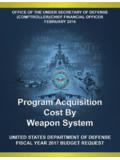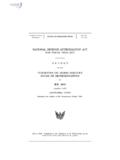Transcription of AFIT/GOR/ENS/93M- 18 DT - Defense Technical Information …
1 AFIT/GOR/ENS/93M- 18AD-A262 492 DT"" I ELECTEAPR 5 190 CBRADLEY FIGHTING VEHICLE GUNNERY:An Analysis of Engagement Strategiesfor the M242 25-mm Automatic GunTHESISJ ames G. RileyCaptain, USAAFIT/GOR/ENS/9 3M- 18 Reproduced FromBest Available CopyApproved for public release; distribution 4 02 1 I;l lEiim _;. 4 000/10 o6/73 THESIS APPROVALSTUDENT: Captain James G. Riley CLASS: GOR 93-MTHESIS TITLE: BRADLEY FIGHTING VEHICLE GUNNERY: AnAnalysis of Engagement Strategies for the M242 25-mmAutomatic GunDEFENSE DATE: 26 FEB 93 COMMITTEE: NAME/DEPARTMENT SIGNATURECo-Advisor Lt Col Kenneth W. Bauer/ENCo-Advisor Prof. Daniel E. Reynolds/ENCAcCesion ForNTIs CRA&./n UnbutincLd 0 ByDIIiu~nA11,daIbii~ty CodesAvdif ;dlidorD is SpectaiAFIT/GOR/ENS/93M-18 BRADLZY FIGHTING VEHICLE GUNNERY:An Analysis of Engagement Strategiesfor the M242 25-mm Automatic GunTHESISP resented to the Faculty of the School of Engineeringof the Air Force Institute of TechnologyAir UniversityIn Partial Fulfillment of theRequirements for the Degree ofMaster of Science in Operations ResearchJames G.
2 Riley, , USAM arch 1993 Approved for public release; distribution unlimitedPrefaceThe purpose of this research was to improve BradleyGunnery procedures. The study of engagement strategies wasundertaken to provide additional guidance for the structureof the 25-mm point target model, based on established US Army Material SystemsAnalysis Activity (AMSAA) methodology, was used to simulatethe gunnery process and provide data output in order toanalyze various strategies and procedures. Although limitedto the single stationary BMP-type target engagement, theresults of the analysis provide definite insight into thestructure of an efficient and effective 25-mm wish to credit COL John Casey with theinspiration for this study. A true student of the Bradleyand gunnery in particular, COL Casey taught me to question,analyze, and improve the methods and tools of our chosenprofession. I would also like to thank Mr. Ken Hilton andDonna Quirido of AMSAA for their invaluable technicalassistance in the development of this thesis.
3 My thesiscommittee, LTC Kenneth Bauer and Prof. Dan Reynolds deservespecial thanks for guiding me through the thesis ordeal andkeeping an open mind when exposed to "Army stuff." Lastly,I am forever indebted to my wife Kathy and two sons,Jonathan and Scott, for their patience, understanding andconstant G. of ContentsPreface ..iiList of Figures ..viiiList of Tables ..xAbstract ..xiI. Introduction .. Background .. 25-mm Chain Gun, M242 .. Bradley Fighting Vehicle Gunnery .. Problem Statement.. Research Objective Assumptions ..e o Research Questions ..o Scope .. Limitations .. Thesis Organization ..14II. Literature Review o o o ..152 .1 D e f i n i t i o n s ..\ .0 ' * .* * .* ..1 Ballistic Dispersion .. Aim Errors \.. Total Dispers on .. Single Round Accuracy Models .. Probability of Hitting aRectangular Ta get Centeredtthe Origin ..20at th r g n .. Offset Probabilities of Hitting ..21iii- Approximation Methods .. Polya-Williams .. von Neumann-Carlton DiffuseTarget Concept.
4 Multiple Round Hit Probabilities .. The Diffuse-Target ApproximationMethod Markov Dependent Rounds Model .. Simulation methods.. Conclusion ..31 III. Model Formulation .. Introduction .. Methods .. Simulation Model POINT TARGET ENGAGEMENT .. Main .. Sensing Rounds and Bursts .. Range-in .. Fire for Effect .. A Methodology for Estimating Quasi-Combat Dispersions for AutomaticWeapons Development Test (DT) Digpersions .. First Round Hit Probability .. Point Target Engagement Simulation ModelDocumentation # Engagement Strategy .. Target Characteristics .. Statistical Counters .. Subroutine Event .. Subroutine Sense .. Computation of Fixed Biases andTotal Dispersions at Target Range .. Range Estimation and ISU Range Index . Calculation of Vertical Miss Distanceon the Target Plane .. Computation of Impact Point .. Burst on Target (BOT) AdjustmentProcess .. SubroutineRANGEIN .. Subroutine FRSTBURST .. Computation of Multiple Round ImpactPoints.
5 Burst on Target (BOT) AdjustmentProcess .. Subroutine KILLBURST .. Subroutine EFFECTS .. Validation and Verification .. 61IV, Methodology .. Introduction Research Procedure .. Experimental Design . Research question #1 .. The model .. The hypotheses tests .. Level of significance andsample size .. The test statistics .. Multiple Comparisons .. Research Question #2 .. The model .. The hypotheses test .. Level of significance andsample size.. The test statistic .. Multiple Comparisons .. Model Adequacy .. 78V. RESULTS .. Research Questionl ..1.. Influence of YAKIMA Aim PointAdjustment Algorithm .. Firing Mode Influences .. Influence of Engagement Strategies .. Research Questionl12 ..0.. Model Adequacy ..88V1. CONCLUSIONS AND RECOMMENDATIONS .. Engagement Strat teyg.. Battlesight Versus Precision Gunnery .. Fire for Effect Bursts .. Recommendations for Further Study ..99 Appendix A: Simulation Model Flowcharts ..100 Appendix B: POINT TARGET ENGAGEMENT Simulation ModelComputer Code.
6 O ..114 Appendix C: Fixed Bias and DispersionRegression Equations ..130 Appendix D: Analysis of Shotgun Model A~swt~ption .136viBibliography ..140viiList cf FiguresFigure 1. ISU Reticle with Choke Sight ..6 Figure 2. Weapon System Delivery Errors ..17 Figure 3. Rectangular Target Centered at the Origin .21 Figure 4. Multiple Round Ballistic Dispersion,Shotgun Model .. 30 Figure 5. Main Program, POINT TARGET ENGAGEMENT ..34 Figure 6. Subroutines SENSE and FRSTBURST .. 36 Figure 7. Subroutine RANGIN .. 37 Figure 8. Subroutine KILLBURST ..38 Figure 9. Target Representation of BMP .. 46 Figure 10. Vertical Miss Distance ..53 Figure 11. Bradley Gunnery Process ..65 Figure 12. Distribution of Target Kills by EngagementStrategy ..66 Figure 13. Engagement Strategy -Firing ModeInteraction n .. 67 Figure 14. Interpretation of Engagement Strategy -YAKIMA Algorithm Interaction ..69 Figure 15. Interpretation of the YAKIMA Assumption onModel ..82 Figure 16. YAKIMA Aim Point Adjustment Algorithm.
7 86 Figure 17. Engagement Strategy Comparison ..91 Figure 18. Precision and Battlesight Mode Performanceby Engagement Strategy ..94 Figure 19. Comparison of Range Estimation Procedures .96 Figure 20. Comparison of Battlesight and PrecisionGunnery Performance .. 97 Figure Al. POINT TARGET ENGAGEMENT ..101 Figure A2. POINT TARGET ENGAGEMENT (cont) ..102viiiS.. _-Figure A3. Subroutine EVENT ..103 Figure A4. Subroutine EVENT (cont) ..104 Figure A5.* Subroutine EVENT (cont) ..105 Figure A6. Subroutine SENSE ..106 Figure A7. Subroutine SENSE (cont) .. 107 Figure A8. Subroutine RANGIN .. 108 Figure A9. Subroutine FRSTBURST .. 109 Figure A10. Subroutine FRSTBURST (cont) ..o..o 110 Figure All. Subroutine FRSTBURST (cont) .o .o ..111 Figure A12. Subroutine KILLBURST .. 112 Figure A13. Subroutine KILLBURST (cont) .. 113 Figure C1. Scatter Plot of Fixed Bias Data .. 132 Figure C2. Scatter Plot of Total Dispersion Data .. 134 Figure D1. Time Series Plot of Vertical Axis ImpactCoordinates.
8 138 Figure D2. Time Series Plot of Horizontal Axis ImpactCoordinates ..139ixList of TablesTable 1 First Round Hit Probability -M791 APDS Ammunition 25-mm M242 Gunversus x Meter Target .. 29 Table 2 25-mm DT Dispersion Estimates ..40 Table 3 Input Values to PHI for 25-mm APDS-TM791 Round Fired From M242 Gun Mountedon SFVS ..42 Table 4 Target Attributes .. 45 Table 5 Visible Width (m) of a BMP Oriented at VariedAngles ..47 Table 6 RESULTS FROM PHi Fixed Biases and TotalDispersions ..50 Table 7 Cumulative Range-in Probabilities andAverage Niumber of Range-in Rounds ..85 Table 8 Tukey's Studentized Range (HSD) Test ..87 Table 9 Target Hits by Burst Length ..88xAbstractThis thesis studies various engagement strategies forthe Bradley Fighting Vehicle's 25-mm automatic gun firingAPDS-T ammunition against a BMP-type target. The Armycurrently provides only the broadest guidance for thestructure of the 25-mm point target engagement which resultsin the employment of an assortment of strategies throughoutthe Bradley community.
9 The goal of this research was todetermine if a best method gur-^-y is a complex set commander/gunnerinteractions which can be difficult to represent with theanalytic models commonly found in the literature. A model,based on the simulation methods used by the US Army MaterialSystems Analysis Activity (AMSAA), was developed to simulatethe gunnery process in order to analyze the effects offiring a set pattern of single sensing rounds and multipleround bursts for the purpose of 'killing' the of variance techniques were used tocharacterize the effects of engagement strategies, precisionand battlesight firing modes, and the burst on target (BOT)direct fire adjustment technique on the simulated Bradleygunnery process. Based on these results, conclusions andrecommendations concerning the structure of the 25-mm pointtarget engagement are FIGHTING VEHICLE GUNNERYAN ANALYSIS OF ENGAGEMENT STRATEGIZES FOR THE 25-MM GUNZ. BackgroundNew technology and doctrinal concepts have changed theface of the Army.
10 Our senior planners envision that thenature of modern warfare will lead to future battles ofunprecedented scope and intensity. To meet this challengethe Army identifies three essential components to superiorperformance in combat: superb soldiers and leaders; a sounddoctrine for fighting; and the finest weapons and supportingequipment and foremost, well trained and well led soldiersare the key to victory in future battles just as they havebeen in the past. The Army places a premium on recruitingquality soldiers and providing the most realistic anddemanding training tell their soldiers 'how to fight', the Army hasdeveloped AirLand Battle Doctrine. As described in FieldManual (FM) 100-5, AirLand Battle "reflects the structure ofmodern warfare, the dynamics of combat power, and theapplication of the classical principles of war tocontemporary battlefield requirements" (7:9). A key aspectof this doctrine is its focus on combined arms operations;the coordinated use of Armor, Infantry, Field Artillery,Army Aviation, and Air Force Close Air Support (CAS) to1/maximize the tremendous lethality of numerous weapon systemsand destroy the provide the best weapons and equipment for Americansoldiers to fight with on the modern battlefield, the Armyhas developed new systems for eech of the major combat arms:the Ml Abrams main battle tank; the AH-64 Apache attackhelicopter; the multiple launch rocket system (MLRS); and,the subject of this research, the M2 Bradley infantryvehicle.
















